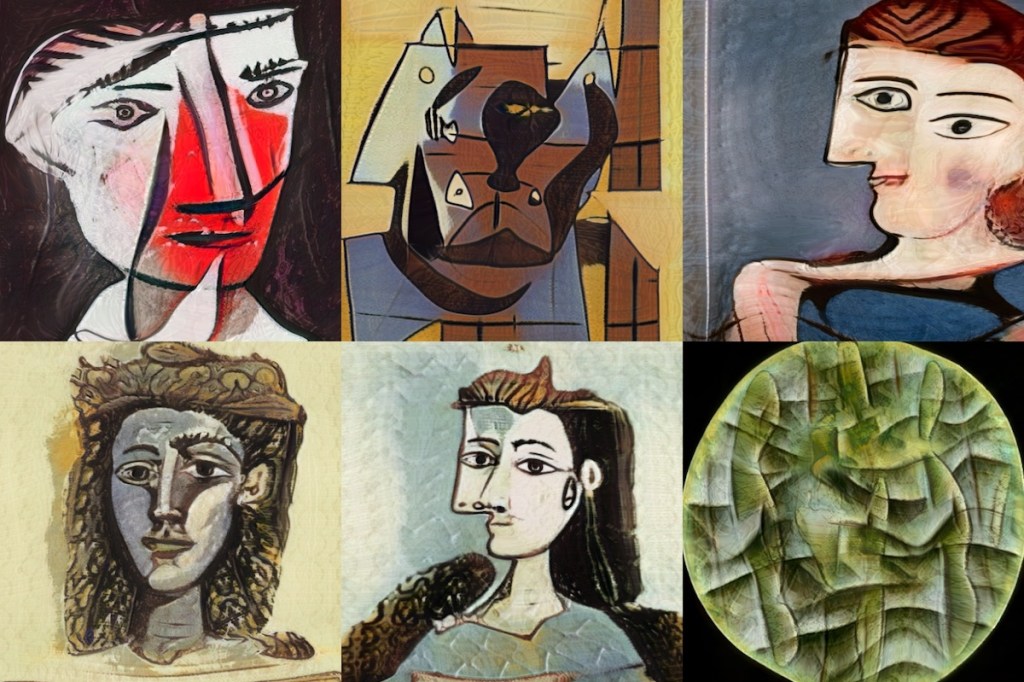Fifty years after his death, Pablo Picasso is painting once again.
The late Spanish master has been reborn as a form of artificial intelligence (AI), a “neural network” created by two UC Santa Barbara doctoral students to generate original pieces of art in his signature styles.
Inspired by a recent trip to the Picasso Museum in Barcelona, the pair fed their creation hundreds of online images of the artist’s paintings to plot and study, and it has since produced more than 10,000 pieces of its own.
The new works ― which mirror the evolution of Picasso’s career, from his blue and red periods to his cubist and surrealist years ― are now available for purchase as NFTs, or non-fungible tokens, for around $5 each by credit card or cryptocurrency at thepicassoproject.org website. A step-by-step explanation of the “minting” process is available there as well.
“In contrast to exhibitions that showcase artist retrospectives, the Picasso Project capitalizes on machine learning to offer our interpretation of Picasso as a prospective,” said the two makers, who emphasize they spearheaded the effort on their own time and on their own dime, completely separate from their PhD studies in UCSB’s materials science department. “Our mission is to create beautifully diverse and original NFT art while simultaneously expanding the notion of generative art.”
Given the “wild and evolving” nature of the involved technologies, the pair explained, they opted to keep their names off the website and asked to be identified in this article only by the pseudonyms architectus and philosopha. But they encouraged anyone curious about their AI-generated collection to engage them directly by emailing team@thepicassoproject.org.
“We want to empower people to educate themselves about these topics in a very straightforward, low-cost way,” said philosopha, who personally gravitates toward the vibrant colors of Picasso’s surrealism period. “We want to spark curiosity, demystify these technologies, and above all pay homage to the artist while re-imagining his genius.”
Too often, continued architectus, who favors the artist’s cubism works, conversations around NFTs have been dominated by high-price purchases of images by celebrities as status symbols. Take, for instance, the Bored Ape Yacht Club craze and the negative press it engendered. By contrast, “Our idea was to create an accessible collection where the barrier to entry was very low but you still get a cool piece of original art out of it,” architectus said.
Most NFT projects emphasize redundancy, relying on minute variances on a common theme, architectus explained. To continue the comparison, only hats, sunglasses, and clothing separate the Bored Apes. Meanwhile, every single one of the Picasso Project pieces is truly unique. “Each work of art in the collection has intrinsic value on its own.”
The purchased images measure approximately 1,000-by-1,000 kilobytes and can live permanently in your digital wallet, or they can be produced as 12-by-12 inch prints. If the buyer wants a higher-resolution image to make a large print, the pair is happy to upsize the file for free, they said. A portion of their sales will benefit nonprofit organizations that give underserved youth the opportunity to experience and make art.
There may be purists out there who criticize the project as a perversion of human creativity, philosopha acknowledged. But Picasso himself pushed the boundaries of art, playing with different types of media to express a kaleidoscope of emotion. philosopha sees his open-minded experimentation as “a natural starting point as we continue that ethos.” And heading off at the pass any accusations of “stealing” Picasso’s style, philosopha noted how he borrowed heavily from traditional African art and that almost all artists draw inspiration from others. “I think everyone, whether it’s AI or a person themselves painting, has to determine where that line is,” philosopha said.
The pair is already thinking about building more neural networks to paint like other famous artists. Monet is a possibility. So is Van Gogh. Their only constraint is identifying painters with large enough bodies of work for the machines to accurately learn from. “This is artwork with unlimited possibilities,” said architectus.
Support the Santa Barbara Independent through a long-term or a single contribution.

